Looking for the best home defense carbine? Maybe that’s the 9mm AR15… or maybe it isn’t…
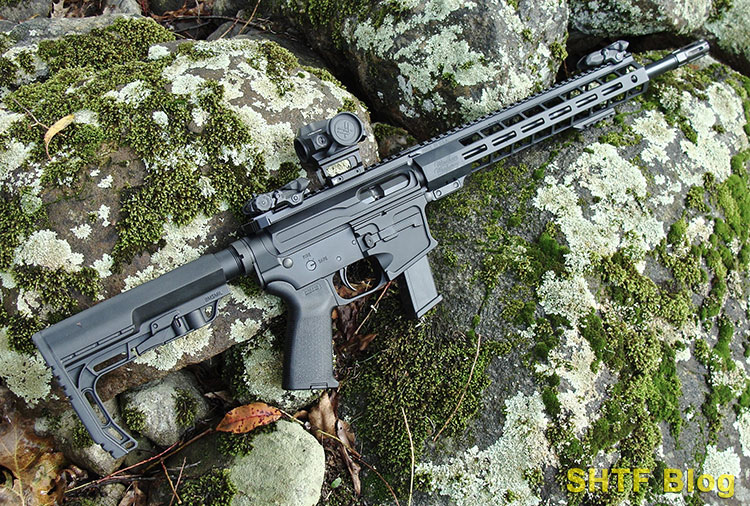
When the Armalite Rifle first appeared no one could have imagined its potential. As it turned out, the M-16 and its civilian counterpart were ideal platforms for continuous evolution to the point where, after five-plus decades of steady refinement, the AR-15 in its various forms has become “America’s Rifle.”
The Austrian Glock arrived later, but its meteoric rise led to some U.S. production. Today, it probably rivals (or even exceeds) the time-tested 1911 for the top U.S. pistol slot.
Meanwhile, the 9mm Luger cartridge lurked in the background for the better part of a century until, at least partially thanks to Glock, it surged to first place among handgun calibers. Inevitably, aspects of all three were melded into one firearm: an AR-15 capable of accepting 9mm Glock magazines. The result appears to be another winner.
Rise of the Pistol Caliber Carbine
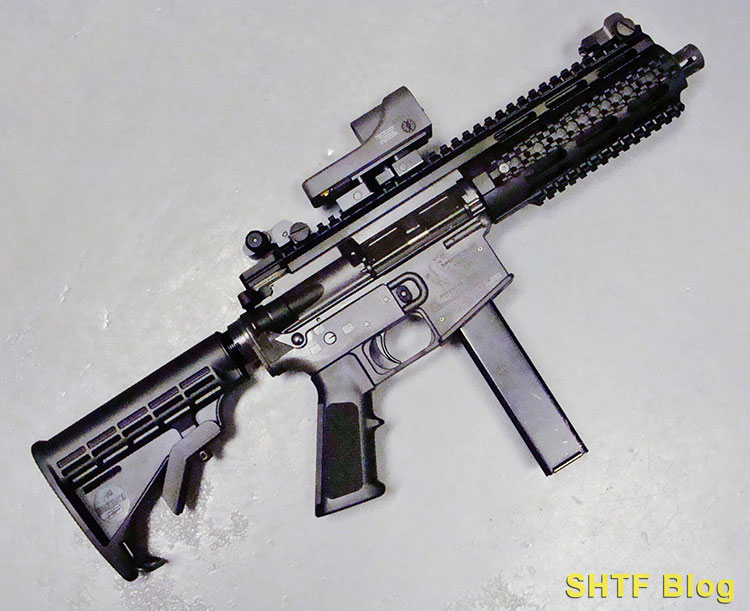
It’s worth noting that 9mm firearms with shoulder-stocks are far from a new idea. Actually, they predate the Great War. Through WW II and beyond, most were SMG variants which eventually extended to the AR platform.
Whether true buzz-guns or civilian semiautos, most utilized AR-15 lower receivers, fitted with adapters to accept Sten Gun or Uzi magazines. However, the newest wave of AR pistol caliber carbines (PCCs) incorporate entirely different lowers, configured for G-17 mags.
This is good news for Glock Pistol owners – and others. The trickle of Glock-type ARs rapidly swelled to a tsunami. Now just about every AR manufacturer catalogs a Glock-friendly 9mm AR. Predictably, demand sparked competition, resulting in other good 9mm PCC choices such as the
The first two use proprietary magazines, but Ruger’s PCC comes with interchangeable mag-wells for use with Ruger’s SR or Glock pistol magazines. A plus for many, operationally, it has much in common with Ruger’s 10/22.
Common-Caliber Systems
The value of a common-caliber handgun and rifle has been recognized since the 1800s, the primary advantage involving simplified logistics; an important concern on the frontier. Ironically, the same situation has resurfaced due to our ongoing ammo shortage.
The common caliber theme is one I drive home in my book Survival Guns.
- Markwith, Steve (Author)
- English (Publication Language)
- 106 Pages - 08/18/2014 (Publication Date) - Prepper Press (Publisher)
Whether .38/40 or 9mm Luger, one or two precious boxes can feed a carefully chosen sidearm along with a carbine for extra reach. If both can share the same magazines, well, so much the better!
If not, no worries; Glock-pattern magazines are cheap and abundant. That’s where I was at when considering a PCC for home defense.
As a fan of S&W M&Ps (consider the M&P 15-22), I’d been holding out for compatible AR. The pickings remained slim so I finally knuckled under. The choice would be a Glock version with a few essential features.
The 9mm AR-15 for Home Defense
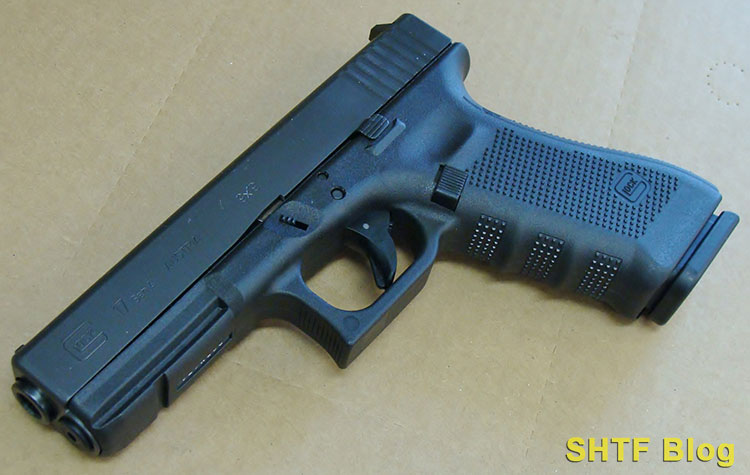
For me, an AR-15 was the logical choice. For starters, it’s the system I’m the most comfortable with. Because of previous experience with military versions in harm’s way, I can still run an AR on auto-pilot.
Subsequent LE and civilian use helped maintain the requisite skills, which transfer nicely to PCC versions, and a 9mm AR offered several more advantages.
My nearest neighbors are often the neighbor’s cows. Although home defense remains the top priority, a secondary threat involves a number of unwelcome critters including large wolf-coyote hybrids that can top fifty pounds. The .22 LR is too light for either of these roles.
A .223 is much better, but the 9mm is “enough gun.”
Large pesky animals are off the table for those residing in housing developments, condos, or apartments, but most of us have similar concerns related to penetration, blast, and range. Should something go bump in the night, other concerns will involve maneuverability, and identification of threats. Let’s see how a 9mm fares in this respect.
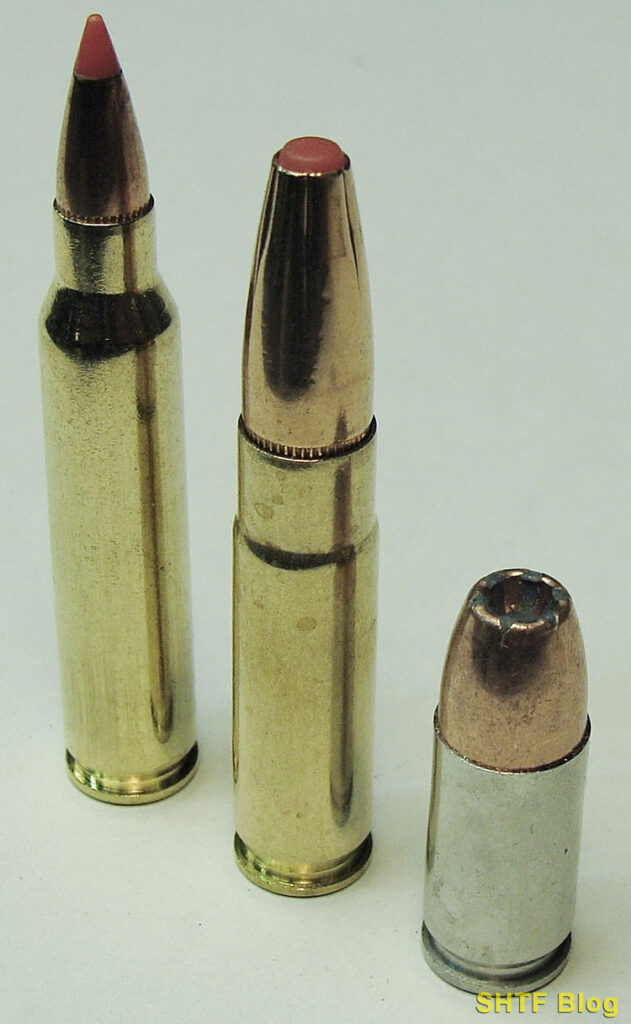
Wall Penetration
Rumors to the contrary, just about any load suitable for defense will penetrate a standard interior wall. That said, a stud or stronger exterior wall could make a difference with a less powerful but still-adequate caliber.
No guarantees though. Actually, some light, fast .223 bullets may completely unravel; a reason they’re seldom chosen for defense (see below regarding comments on frangible ammo).
And then there’s the .300 Blackout. One in my possession is a 10 ½” AR pistol. With a suppressor attached, it’s both flash-free and quiet with Hornady’s expanding Subsonic 190-grain SUB-X load. But, that’s a lot of lead; more than I’d care to sling about the house.
A lighter (115-124-grain), larger-diameter 9mm bullet traveling at a similar velocity seems at least somewhat safer – and many are geared specifically for defense.
Blast & Flash
Here, a 9mm has the clear advantage over a .223/5.56 NATO, or just about any other worthy centerfire rifle caliber. We (the cadre of my government firearms training unit) took a close look at 9mm submachine guns (SMGs) for use inside steel and concrete structures.
Unless you have the necessary protective gear, plan on temporary blindness and ringing ears after only one shot from a 5.56. By comparison, a short-barrel 9mm AR was tolerable, even when unsuppressed in low light.
There are ways to reduce muzzle flash, but every modifications has its pros and cons.
We played with suppressors and frangible bullets in hopes of avoiding a high-velocity pinball scenario but, of course, things are seldom simple. Frangible (non-lead, disintegrating bullets) are lighter, and 9mm ARs don’t use gas systems. Instead, most are old-school blowback designs that use a one-piece bolt and carrier, usually with an extra weight added to the rear.
This mass serves to delay unlocking, but reliable function is a ballistic balancing act which can be compromised by extremes – a problem we encountered with the above combination. The remedy depended a large consistent lot of 9mm frangible loads, and a tuned buffer or bolt-weight, determined through trial & error.
In the end, we just stuck with our 5.56 AR-15s and added 11 ½” suppressed uppers. The small-caliber fast bullets usually disintegrate against hard surfaces anyway and, when suppressed, the report is similar to .22 Magnum (rifle) – with zero flash. Of course, this solution involves NFA registrations and fees.
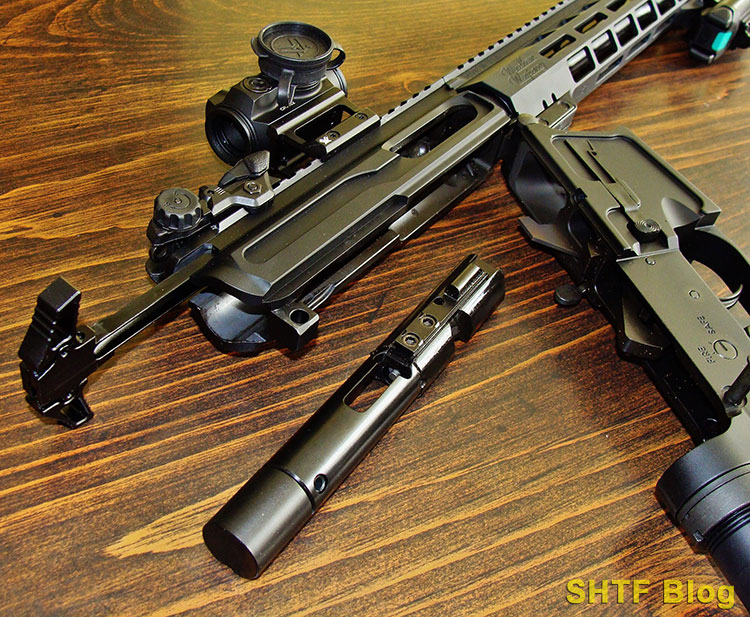
Frangible Loads?
For most homeowners, a 9mm AR probably sounds a whole lot simpler. But, what about those frangible loads?
Most will completely disintegrate upon contact with hard surfaces, even from a glancing strike – BUT, they’ll still penetrate drywall and wood. Function concerns aside, their defensive value is also iffy, making a proven 9mm JHP the better all-around choice.
Maneuverability
Tight spaces call for compact firearms, a requirement AR-15s can meet. Even a 16” carbine can become relatively compact if equipped with a telescoping stock that’s adjusted to its shortest settings.
A short-barreled rifle (SBR) is better but, like a suppressor, it’ll be subject to the NFA process. The less complicated alternative is an AR pistol – or, maybe, just a handgun.
Target Identification
Positive target I.D. is essential, calling for a light. Here again, the AR platform shines (sorry). Today’s railed forends can accommodate all sorts of lights, along with other useful accessories (covered below).
Retention
A close-proximity armed response poses the risk of a “snatch” from an aggressive adversary. Here, with proper techniques (and training) a handgun can have an edge.
If using an SBR or carbine, a sling can help – maybe. Its greatest advantage is the freeing of one or both hands, to cover other tasks – such as 911 communications. Another sling advantage is weight-bearing during possible periods of prolonged readiness. These needs can be easily addressed thanks to the numerous AR sling possibilities.
A 9mm PCC or Just a Handgun?
My 9mm carbine may not be the ultimate choice for indoor settings, but four-legged outdoor invaders could involve 100 yards shots – too far for a handgun. Actually, an AR pistol could do the trick with a caveat: inclusion of a brace. I was really torn between the two iterations, having shot SBR 9mm SMGs with great results out to 100 yards.
But braces have received recent political flak. Hopefully, they’ll survive. If so, even after adding a suppressor, a longish 10 ½” pistol won’t exceed the length of a 16” carbine. Not that a “can” is a 9mm necessity. Skip it and you’ll realize substantial weight savings.
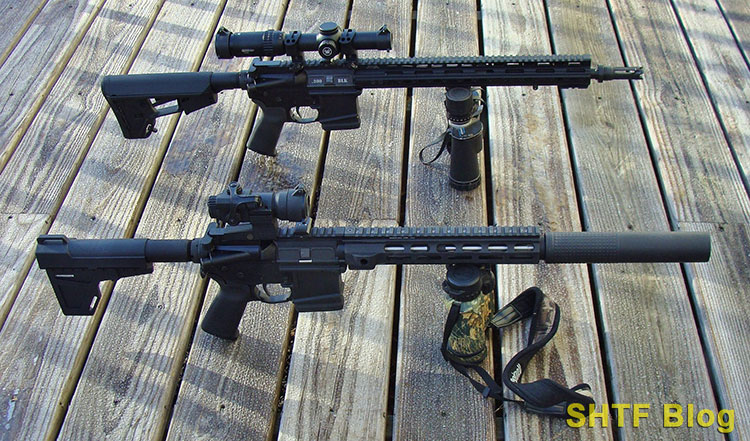
The Handgun Option
If lacking a brace, I’d opt for a conventional pistol. Yes, you can attach a single-point sling to your AR pistol, but single-point slings are rife with problems. Stability will improve at full extension, but accuracy will still suffer, and it’ll dangle energetically during movements.
A conventional handgun with a light (or light/laser) will probably cost less while offering better maneuverability and retention. For those who carry regularly, it’s also the logical choice. Good chance a rapid-access home storage system is already established. If so, when needed ASAP, regular handling provides the muscle memory required during stress.
The downside? A handgun of any type is harder for most folks to master than a firearm equipped with a stock. Home defense ranges will probably be short, but consider this sobering statistic: The hit probably for trained LE personnel in armed confrontations is around 20%; one out of five shots fired – at distance inside five paces!
A handgun has an edge in close quarters but only with solid skills.
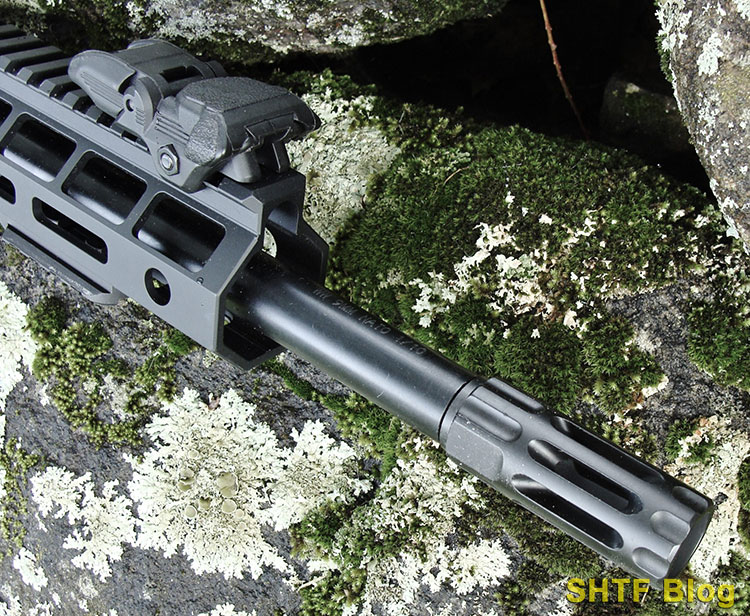
Ballistic Comparisons
A 9mm PCC pistol variant will produce the same approximate velocity as other handguns. Most can be fitted with flash-hiders but good defensive loads are often formulated to produce minimal flash in standard 4-inch pistols. Handgun-wise it’s a pretty much a wash.
A 16-inch 9mm carbine barrel can boost velocity, usually on the order of 15%. Most defensive 9mm handgun bullets won’t disintegrate from this boost, although expansion could increase, to possibly decrease penetration. This could be a plus regarding collateral damage, but I wouldn’t bet the farm on it.
How About Both Firearms?
That’s my plan using a Hornady Mini Rapid Vault; assuming it ever escapes back-order. The provided RFID features provide rapid access through a simple swipe. A similar plan could have real potential for Glock owners with compatible PCCs.
But, of course, I messed that up through the use of an S&W 9mm M&P Compact. But one thing they’ll have in common is a light. The vault is slated for a bedside installation – because not everything that happens in the dark is good.
Sights & Accessories
For close distances, especially in low light, a dot-sight is hard to beat – assuming it combines easy activation with dependability. These sights also have unlimited eye-relief; ideal for adjustable stocks and/or multiple users.
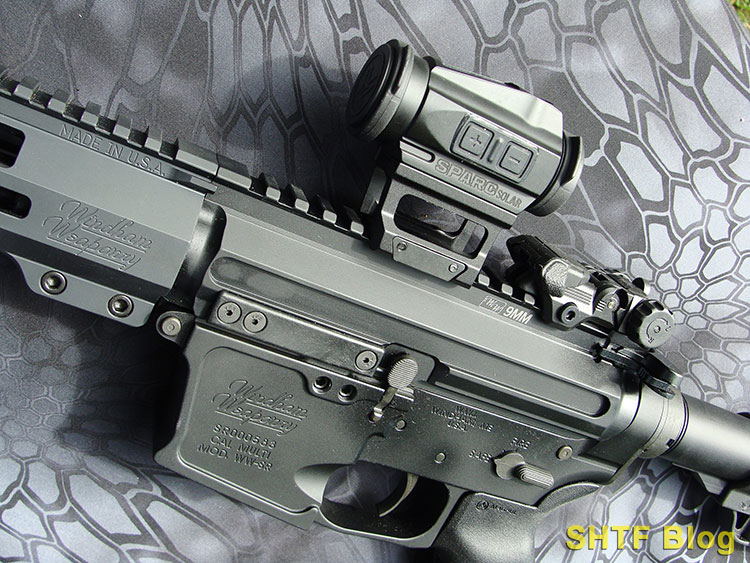
Aiming Systems
We equipped our agency’s 5.56mm carbines with Aimpoint Pros. With a battery life of 30,000 hours, we just leave ‘em on and install fresh ones every January. I was ready to spring for my own until getting the opportunity to try a Vortex SPARC Solar. Like the Pro, the Sparc has an adjustable-intensity 2 MOA red dot housed within a 30mm tube with lens caps.
- The SPARC Solar red dot offers users up to 150,000 hours of battery life by implementing Auto D-TEC technology, which detects ambient light and automatically switches between solar and battery power...
- With motion activation, the SPARC SOLAR can be left in sleep mode and will automatically turn on when brought up for action. When enough solar power is present, the unit will work without a battery...
- Fully multi-coated lenses and a larger aperture, 22mm sight window; the daylight bright, 2 MOA dot provides a precise point of aim featuring 10 daytime illumination settings and two night-vision...
- The SPARC Solar Red Dot can be mounted at two heights, lower 1/3 co-witness and a low mount option. A captive flip cover system secures to the battery cover—no more searching for caps when it’s...
Battery life (CR2032) is rated for 150,000 hours if augmented by its integral solar panel. I doubt it’ll see much sunlight in my safe, but the 14-hour auto shut-off should conserve juice. The slightest movement reactivates the reticle to its previous setting. The result is a grab & go system, useful 24/7.
For a bit of extra insurance I added a polymer folding BUIS sight set which co-witness in the lower third of the SPARC. Next came one more option…
Lights & Lasers
A spare Olight BALDER-Pro was languishing on a shelf, so I clipped it to the forend of my 9mm carbine after installing a short M-lock rail at 6:00. Although designed primarily for handguns, the Olight is plenty bright and it even has a built-in laser – reassuring with a primary aiming system dependent on a battery.
The laser’s beam is green, which differentiates it from the SPARC’s red reticle. I adjusted the laser’s beam to project 2” below the SPARC’s dot at 7 yards; thereby eliminating the close-range offset typical of AR sighting systems.
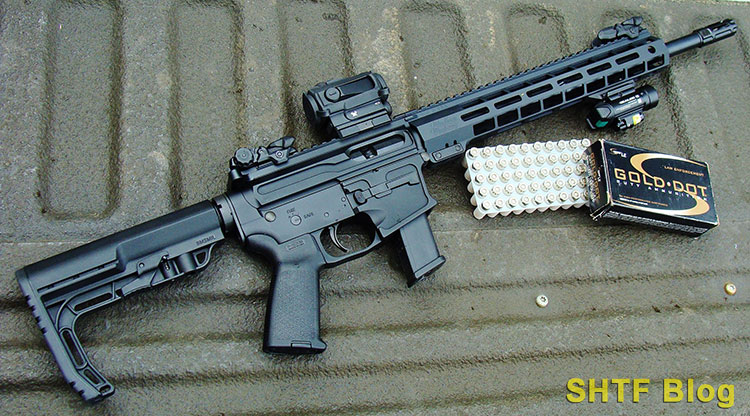
Sling: As a temporary measure, I hooked on a spare single-point, however, a two-point sling is in the cards. A sling can be a liability in some tight environments but, without one, best case, you’re one-handed.
9mm Home Defense Carbine Finale
I wound up buying a 9mm Windham Weaponry AR for a few key reasons. The first involves positive experience with a large inventory of our agency’s WW AR-15 carbines, all of which are still going strong despite years of 5.56 consumption.
Another is WW’s last-shot lock-back feature, not common among all 9mm ARs but one I regard as essential. And, then there’s the AR platform itself, which opens the floodgates to all sorts of parts and accessories…
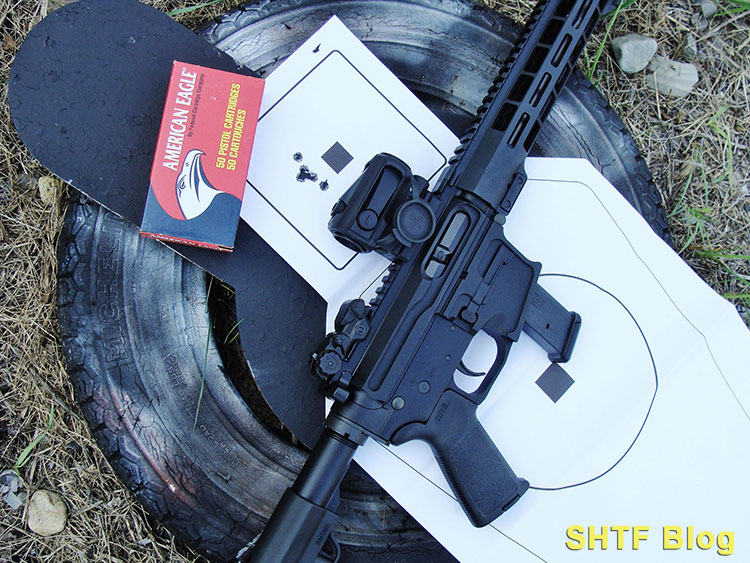
Because my WW 16-inch Carbine was ordered through the factory, I spec’d a few upgrades, including an MFT Minimalist Stock and a Magpul grip (good for storing spare batteries). It ships with a sling, QD swivels, and a knurled thread-protector which I later exchanged for a Wilson Q-Comp. The last addition was an oversized ambidextrous charge handle to help clear the folding rear sight.
It comes as no surprise that function has been flawless, using 17-round Glock or P-mags. I bought a half-dozen of the later just to be safe in the event they become scarcer than toilet paper. When zeroed at fifty yards, 5-shot groups run around 2” with Speer 124-grain Gold Dot JHPs. Federal 124-Gr.
American Eagle FMJs perform similarly, for more affordable practice. Accuracy might improve with a better trigger than the factory’s mil-spec version, but it’s good enough to do the job. Recoil is fairly snappy due to the heavy reciprocating bolt, however, noise and blast are mild despite the Q-Comp.
My only real complaint is the size and weight of the final carbine (actually, still pretty much average). Others might be happier with a braced pistol version but, beyond occasional trips to the range, I doubt mine will see much travel time. Some other designs incorporate take-down features for compact transportation, but an AR can do the same by simply popping its two receiver pins.
Bottom line: Mission accomplished.
Want to learn more? See Steve Markwith’s related book, Centerfire Rifles: A Buyer’s and Shooter’s Guide: Special AR-15 Section Included.
- Markwith, Steve (Author)
- English (Publication Language)
- 264 Pages - 12/03/2016 (Publication Date) - Prepper Press (Publisher)




2 comments
I had that exact same WW 9mm carbine for three years. Ran it through carbine courses, shot the hell out of it. My assessment was that the size was too large for so little ballistic gain – my tests showed only about 200 or so FPS gain with most given loads. Even handloading, the little 9mm case doesn’t have the capacity to stuff enough slow-burning powder in it to take advantage of 10+ inches of barrel. I sent it packing after careful consideration. With a 10″ barrel and a can it makes more sense, but where the expenditure to buy a supressor and shorter barrel wasn’t in the cards, the 9mm wasn’t worth taking up room in the safe for my perceived needs.
Keltec Sub 2000…cheaper and a better option. The 9 is to be used to defend and get the he’ll out.